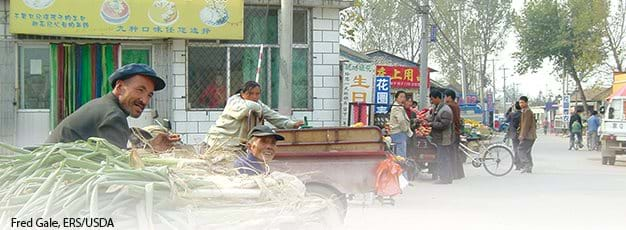China's Food Market Revolution Reaches the Countryside

Evidence of China's thriving food industry—bustling restaurants, modern supermarkets, and glitzy hotel banquet rooms—abounds in the country's prosperous coastal cities. But to get a complete picture of food markets in the world's most populous and fastest growing country, one must take a closer look at food consumption patterns in China’s vast rural hinterland—home to over 60 percent of China's 1.3-billion population.
Rural households in China grow much of the food they eat and subsist on food expenditures that averaged just $107 per person (30 cents per day) in 2003. Yet, while their low level of food expenditure suggests high poverty, China's rural population is generally not malnourished. China's rural households—historically cash-poor but with plentiful labor and an egalitarian distribution of communal land—meet most of their basic nutritional needs on a diet composed mainly of rice, wheat flour, other grains, and vegetables that they grow themselves. They consume relatively little meat, fish, dairy products, or processed food. By minimizing cash outlays on food, households can save their cash for school fees, house construction, consumer durables, and other goods and services.
While rural consumption patterns still differ sharply from those in urban areas, the last decade saw a slow but steady trend toward commercialization in rural food markets. While rural consumers' per capita purchases of food remain small in dollar value, their inflation-adjusted cash expenditures on food increased more than 70 percent during 1994-2003. The value of self-produced food consumed by rural people declined over the same period, and the cash share of rural food expenditures rose from 45 percent to over 60 percent.
The revolution that has transformed China's urban food markets is starting to spread to rural areas, as greater availability of cash income, more efficient markets, better communications, and improved transportation help bring rural people into the mainstream of the economy. Supermarkets and restaurants are opening in small towns and villages, and food product distributors are now including rural areas in their marketing plans. While there is still a long way to go, the advance of China's food revolution into rural areas promises to unify the country into a national market and substantially change the mix of foods consumed by the Chinese people.
Commercialization of Food Consumption in Rural China, by Fred Gale, Ping Tang, Xianhong Bai, and Huijun Xu , USDA, Economic Research Service, July 2005
China's Modernizing Supermarket Sector Presents Major Opportunities for U.S. Agricultural Exporters, AgExporter, November 2004
China Agricultural and Economic Data, by Fred Gale, USDA, Economic Research Service, August 2019
China, by Fred Gale and Jessie Lin, USDA, Economic Research Service, June 2024


